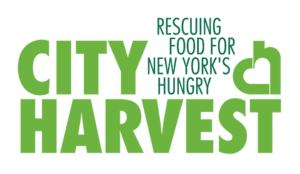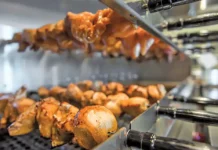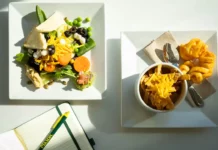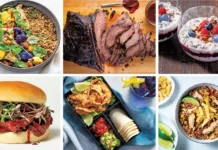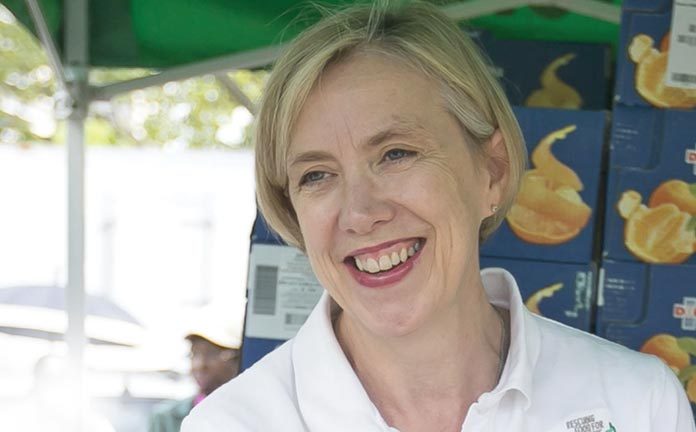
Since becoming Executive Director in 2006, Jilly Stephens has overseen City Harvest’s efforts to meet the rising demand for hunger relief while putting in place long-term initiatives to address the health and nutrition needs of low-income communities in New York City. Jilly joined City Harvest as Senior Director of Program Development in 2004, where she played an important role in developing the organization’s expanded community services that evolved into City Harvest’s Healthy Neighborhoods initiative.
Prior to joining City Harvest, Jilly Stephens served as the Vice President of Program Operations at ORBIS International, an $80+ million nonprofit organization dedicated to the elimination of avoidable blindness through hands-on surgical training and education.
Last month at the International Restaurant and Foodservice Show of New York, Stephens was presented the Beacon Award for her hard work with City Harvest by Kathleen Wood, moderator of The Foodservice Council for Women.
Total Food Service sat down with Jilly Stephens to discuss her beginnings with City Harvest, the non-profits past and present initiatives, and their next steps in battling hunger in New York City.
What was the vision behind City Harvest?
We’re celebrating our 35th anniversary this year. We were surrounded by New Yorkers who saw really good food going to waste and at the same time they were very aware of so many New Yorkers in need. That really is how we began.
Our first executive director had been working at a soup kitchen on the Upper East Side. She enjoyed the potato skin appetizer and took the opportunity of asking the chef what he did with the flesh of the potatoes. He told her that they were just thrown out. So she asked if she could come back and collect them and really that’s how we started.
It is hard to fathom that a simple potato skin could serve as a launching pad for a program that has gone on to touch so many.
Our model for rescuing food is essentially the same today as it was back then just on a much larger scale and produce is still a big part of what we rescue and deliver.
Let’s talk about how that vision has changed in all these years. How simple potatoes turned into something so magnificent that has touched so many people.
I think it’s important to note that we’re still doing what we did back then – always focusing on solving hunger and food problems and bringing those two things together to feed our neighbors. I would say the difference today is it’s on a much larger scale. 35 years ago volunteers were using their cars to get food where it needed to be.
Today our fleet of trucks will rescue 60 million pounds of food this year and distribute it to a network of 500 kitchens and food pantries. We are also proud of each of those drivers of our 22 trucks that are trained and committed to service safety. So we want to make sure that every time the food we rescue is safe.
The core of our program is getting that great food into the hands of hungry New Yorkers. At the same time we have programs that really go deep into some of the poorest neighborhoods in the city and help to make sure that the hungry have access to good quality affordable nutritious food. Our goal is to provide a balanced nutritious healthy diet with a focus on lots of fresh fruits and vegetables.
Can you talk about your background before you came to City Harvest?
Before City Harvest I ran the program for a big international medical charity. And I worked in the field in developing countries for that organization for many years and then was transferred to the headquarters in New York City. And while I was there I became a donor to City Harvest.
You know having worked in developing countries for 10 years it was really mind blowing to arrive in NYC and find that there could be so many hungry people here. It just didn’t sit well with me. I realized that there are a lot of people – millions who really struggle to make ends meet. And that’s what brought me to City Harvest.
I fell in love with City Harvest and got to know the then executive director and was fortunate enough by staying in touch to be offered a position here.
Can you talk about the size and scope of hunger in NYC?
I would say that hunger in New York City is consistently high. We saw the numbers spike around the time of the great recession, as did visits to soup kitchens and food pantries. In the year between 2008 and 2009 hunger shot up by 15 percent in just one year. And although we’ve never seen such a sharp increase since, we haven’t seen a decline in visits to soup kitchens and food pantries either. People are often surprised to hear that while there’s a large and visible homeless population in the city, that there is an even larger population of hungry New Yorkers.
Many of the hungry have homes and jobs and a good education. It’s just a tough city and very expensive to get by. After paying rent, utilities, and any medical bills, it becomes a challenge to put food on the table.
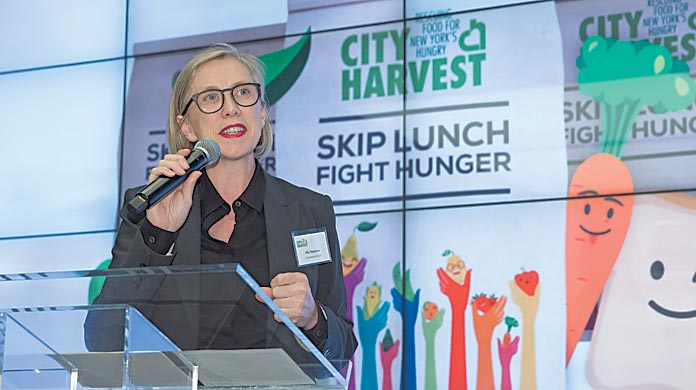
What do the statistics say about the size and scope of hunger in New York City?
We know that almost 1.3 million of our neighbors just in the five boroughs are struggling. One in five children don’t always know where their next meal is coming from. That means they may no longer be eligible for food stamps or SNAP benefits because they earn too much household income, but they’re still the ones who are struggling to put food on the table. They may not be categorized as food insecure by the government’s categorization but they’re still struggling.
What role do chefs and restaurants play at City Harvest?
Chefs are really important to us and have been since those very first potatoes. Restaurants were at the heart of our founding and continue to be so today. Many chefs and restaurants continue to regularly donate to us.
There are so many other City Harvest programs that chefs and restaurant owners get involved with that help us feed New Yorkers from all walks of life.
We can then see many ways that the restaurants are involved today from a restaurant like LeBernadin, which does provide a steady supply of food to us. They have a dedicated City Harvest refrigerator that has asparagus, which is fantastic. Restaurants like Landmarc, from Marc Murphy who is one of our board members, donate a prepared meal once a month. An instance of this is when they’ll cook lasagna for 600 people. That’s food we can pick up and easily move through our system.
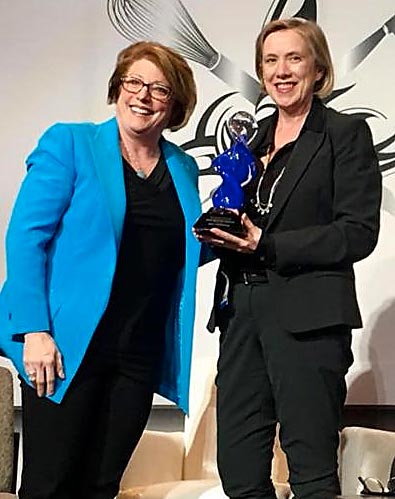
We pick up from them every day and distribute to agencies across the city that has two distribution partners. We work very closely with distributors like Baldor who make great food available. So at every step along the way from the farmer growing the food to perhaps the radishes that have grown too big for them to bring to market, we can take that food all the way through the system. Restaurants can get in touch with any number of people at City Harvest just a call to help them get that restaurant to the right person and they can donate any excess food that they might have. I gave the example of Marc Murphy’s restaurant that is donating a prepared meal once a month. There are several restaurants that do that. We’re looking for a minimum of 50 portions for prepared meals once a month. And there are ways for restaurants to get involved through special events.
How can a restaurant get involved with City Harvest and what are some of the benefits to the restaurant?
We have a series of very popular tasting events. The great thing about something like that is not only are they helping us feed their hungry neighbors but also they’re in front of their potential dining patrons. Many restaurants will volunteer with us. They particularly enjoy bringing for example their kitchen team or their wait staff as a team to volunteer together. They view that as a good team building effort while giving back to the communities that they feel strongly about.
We have reached out to make the concept of hospitality philanthropy easy. We can only do our work because of the help of so many New Yorkers who want to donate their time or money. It’s our job to make that a good experience for them and to make it easy for them to very clearly see why their help is so important. So we take that very seriously and we work closely with our donors and our volunteers to make sure that it’s a good experience.
New York has a number of charities that a restaurant can work with. Where does City Harvest fit in?
New York City is chock full of great charities. I’ve just come from meeting with leaders of many charities in the city all doing fantastic work to help meet the needs of those who are struggling whether it’s for food or housing or legal assistance on immigration. Our work is to get food on people’s tables and you know I think at City Harvest we are uniquely positioned to partner with restaurants. I mentioned before that the chefs really want to feed people whether they can afford to come into the restaurant or not. I think that’s an approach to the work that resonates particularly with the restaurants and the chefs throughout the city. We know that because they come back time and time again to help us figure out how we can do more to help feed people. I think that’s sort of a unique point for City Harvest. We were born out of the restaurant industry and we still rely on them today as much as we did some 35 years ago.
You have a big gala coming up later this month.
On April 24th City Harvest is hosting its 35th anniversary gala. It will be held at Cipriani, which is where that event happens each year. We will be recognizing people and organizations. Bill Mills is the North America CEO for Citigroup, and he and his wife Wendy have been longstanding supporters since they moved back from Europe. He had been posted there until 2011. Chef Jose Andres will also be honored for his humanitarian efforts particularly feeding people in Puerto Rico after Hurricane Maria and City Harvest was also involved in that effort. We will also honor Chrissy Teigen who is a member of the Food Council and has worked tirelessly to help put a national spotlight on hunger relief work.
What’s your agenda and vision for the next 35 years?
Many charities set a goal of closing because they have accomplished their mission. Unfortunately, hunger is New York City will always be a reality. We will do what we do with our trucks being on the road every day of the week, every week of the year delivering food. We will continue to do that as long as it’s necessary. I hope that we can continue to significantly decrease the amount of hungry people in New York City.
To learn more about Jilly Stephens and her efforts with City Harvest, visit their website.


















